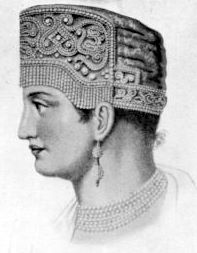|
Russian Pearl Cap "Mushka" Russian Pearl Cap on Lady of 17th Century
This observation is from an 1846 book by Kohl, a German traveler. In Alexandria, a small city in the government of Kherson in South Russia, a Jew kept a cafe, and his charming daughter served us with coffee. We paid her compliments on her beautiful eyes and teeth. But she seemed to be much less vain of these natural ornaments than of the acquired ones in the magnificent glittering pearl cap which she wore upon her head. For all the women through South and Little Russia even as far as Galicia wear a certain stiff, baggy cap which is very disfiguring, and is covered all over with a great number of pearls, upon a foundation of black velvet. It is called a "mushka."  17th Century Pearl Cap
This cap, with very unimportant modifications, has almost always the same form; the only difference is that, in the case of the wealthy, the pearls are larger, and sometimes a number of small pearls and precious stones are suspended here and there, set in the same way as the earrings of our ladies.
It is common for them to wear half their fortune on their heads in this way. For these caps generally cost from five hundred to one thousand roubles, and many are worth five or six thousand and even more; they wear them every day, holidays as well as ordinary days, and strut around the kitchens and cellars with their "mushka." They spend their last penny in order to secure such a Russian pearl cap, and even when they are clad in rags their head is covered with pearls. In order to furnish the requisite material for this wide spread fashion, the commerce in pearls of Odessa, Taganrog and some other places in southern Russia is not unimportant.  17th Century Pearl Cap
There may live in the region where the pearl caps of which I speak are worn at least 2 million Jewesses. Let us estimate that among them there are but 300,000 adults, and that only half of these, 150,000 wear pearl caps (only the most indigent and the most aristocratic do not wear the "mushka"); let us then estimate the average value of such a cap at only five hundred roubles--these are the lowest minima and fall far short of the real figures--and we have a total capital of 76,000,000 roubles, which the Jewesses of this region wear upon their head.
Naturally the annual diminution of this capital is small, since these pearls are transmitted from the mothers to their daughters and granddaughters. Still, if we estimate that they last for a century, the necessary yearly contribution amounts to nearly one million. It is, however, probable that a much larger capital is employed in the commerce of pearls.  17th Century Pearl Cap
They are for the most part, oriental and come by way of Turkey and Odessa or else by way of Armenia and Tiflis. We inquired of our beautiful Jewess whether she was not in perpetual dread on account of her Russian pearl cap, and how she protected it from thieves. She answered that she wore her Russian pearl cap on her head all day and at night placed it in a casket which rested under her pillow. So that the whole short life of these Jewesses of the steppes revolves around their pearl cap as the earth does around the sun. Read about famous pearls after Russian pearl cap.
|






